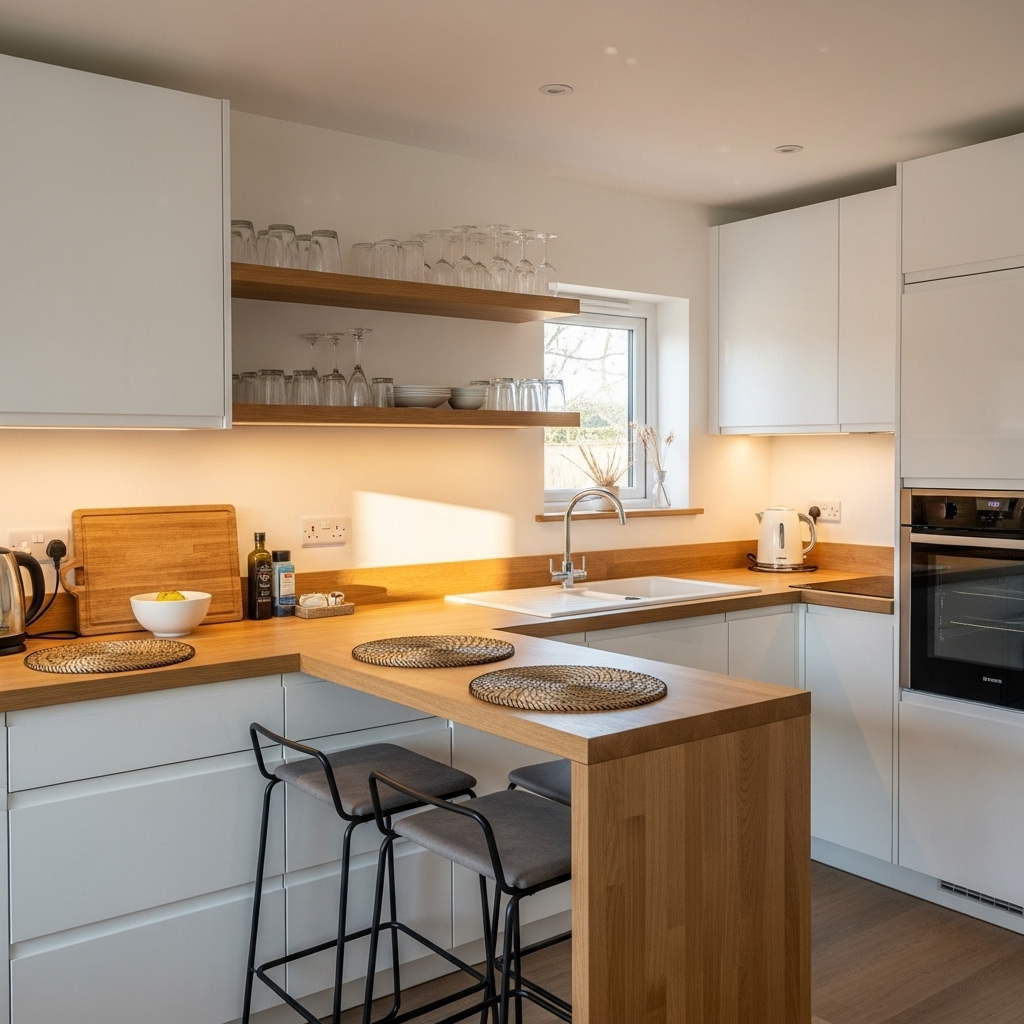Small kitchens have a special kind of charm in Huntington Beach. They invite creativity, demand efficiency, and reward thoughtful design. Whether you’re in a cozy beach bungalow near downtown, a townhome a few blocks from the sand, or a compact condo with a patio that begs for alfresco dinners, the goal is the same: stretch every inch while creating a room that feels bright, open, and effortless to use. With the right plan, a small kitchen becomes the most delightful room in the house.
As you explore kitchen remodeling, remember that small doesn’t mean limited. It means strategic. Every decision—from cabinet configuration to lighting color temperature—has an outsized impact on function and mood. The good news is that small kitchens reward clarity: a well-edited palette, storage that anticipates your routines, and clean circulation can transform daily life without expanding a single wall.
Begin with how you live
Design starts with your habits. Do you make coffee before sunrise and need a quiet corner for the ritual? Do weekend lunches flow to the patio? Do you store specialty cookware or entertain frequently? Mapping these patterns lets the space plan solve for real life. A coffee niche with water line and dedicated outlet can tuck into what was once a cluttered corner. A landing zone near the back door can tame grocery runs. When storage and circulation align with your routine, small kitchens feel generous.
Layout strategies for compact rooms
Galley, L-shape, and single-wall layouts each have strengths. Galleys can be marvels of efficiency when aisles are right-sized and work zones are set in sequence. L-shapes open the room and create a natural corner for a tall pantry or integrated refrigerator. Single-wall kitchens are disciplined, but when paired with a slim island or a peninsula, they offer surprising utility. The best layouts keep prep, cooking, and cleanup distinct while preventing cross-traffic. In Huntington Beach, where indoor-outdoor flow is prized, consider sightlines to patios and how doors swing; a pocket or outswing door can free precious inches.
Storage that works like magic
In small kitchens, storage is the superpower. Drawer bases prevent deep-cabinet rummaging. Tall pantries with rollouts extend capacity without monopolizing width. Corner solutions—like blind-corner pullouts or a well-proportioned lazy susan—turn dead zones into allies. Vertical thinking pays off: full-height cabinets, a rail for everyday tools, and a slim hutch that bridges kitchen and dining blur the line between storage and furniture. Even toe-kick drawers can house baking sheets or kid art supplies. When every item has a home, counters stay clear and the room breathes.
Appliance choices for small spaces
Today’s appliances are brilliantly flexible. Counter-depth refrigerators keep aisles comfortable. Slide-in ranges with front controls streamline the visual line. Compact dishwashers and 24-inch wall ovens can deliver full performance in a tighter footprint. Panel-ready models allow the room’s language—wood species, paint tone, and hardware—to remain continuous, which helps small spaces feel calmer. A well-chosen hood, sized to match your range and ducted outside when feasible, keeps air fresh without overpowering the room.
Light, color, and materials
Light is the great expander. Layered lighting—recessed fixtures for ambient glow, under-cabinet LEDs for shadow-free prep, and a scaled pendant or two—sets the mood and supports function. Pale cabinet finishes, light-toned counters, and reflective splash materials bounce brightness around. That doesn’t mean you must avoid contrast; a deeper island color or a warm wood accent can anchor the composition. In a coastal setting, materials that shrug off moisture and wear are your friends, keeping the room crisp through busy weeks and beach-season weekends.
Countertops and backsplashes
Continuous surfaces simplify small rooms. A single slab counter with a gently eased edge feels sleek and easy to maintain. Backsplashes can be an opportunity for personality—handmade tile with soft variations, a subtle pattern that reads as texture, or a slab continuation that minimizes grout lines. Consider outlet placement early; a thoughtful layout keeps sightlines clean and cooking zones practical. In petite kitchens, these details are the difference between adequate and exceptional.
Smart plumbing and electrical planning
Even in compact spaces, code-compliant outlet spacing, lighting controls, and safe plumbing runs are essential. If you’re adding a small prep sink, plan its role carefully so it supports rather than crowds the main work area. Place switches and dimmers where they feel intuitive. Think about trash and recycling: a double pullout near the sink keeps cleanup fluid and floors clear. These moves don’t add drama, but they add daily ease.
Creating visual openness
Design can trick the eye in honest ways. Full-height cabinets paired with a few open shelves prevent visual clutter while maximizing storage. A counter-depth refrigerator aligns with cabinetry so walkways feel wider. Glass cabinet doors, used sparingly, add depth. A hutch with interior lighting can glow softly at night, transitioning the kitchen into the living space with grace. Clear sightlines across the room and to the outdoors make small kitchens feel connected rather than confined.
Permitting, logistics, and living in place
Compact remodels still benefit from clear permits and inspections, especially when electrical or plumbing is refreshed. Because small kitchens concentrate many trades in a tight footprint, sequencing matters. Cabinet installers, electricians, and tile setters rely on a precise schedule to avoid bottlenecks. Many homeowners live at home through the work; dust control, staged deliveries, and a temporary kitchenette make it manageable. Communication is the thread that keeps everything moving smoothly.
Coastal durability in miniature
Huntington Beach’s salt air and humidity inform material choices. Corrosion-resistant hardware, stable substrates behind tile, and exterior-ducted ventilation bolster longevity. Thoughtful weather sealing around doors and windows keeps the room comfortable. None of these details shout, but their impact is long-lasting, preserving the fresh look you love.
Design process that respects scale
In a small kitchen, every inch counts and every decision is magnified. A disciplined design process—scaled drawings, cabinet elevations, and finish samples under real light—leads to confident choices. Mocking up island widths with painter’s tape can reveal the perfect aisle dimension. Testing hardware sizes against sample doors prevents surprises. When details are resolved on paper and in samples, installation is smoother and the finished space feels precise.
From idea to everyday delight
The success of a small kitchen isn’t measured in square feet but in how effortlessly it supports your routine. When the coffee mug is exactly where you reach, the prep knife slides out without a hunt, and the path to the patio is clear, the room feels bigger than it is. That’s the magic of good design: it anticipates, supports, and quietly brightens daily life.
Frequently Asked Questions
Can a small kitchen include an island?
Yes, when circulation is protected. A slim island or a peninsula with carefully planned overhangs can add prep space and seating. The key is proportion—aisles must remain comfortable for two people to move without conflict.
How do I get enough storage without making the room feel crowded?
Use vertical space with full-height cabinets and integrate rollouts and drawer bases to maximize access. A hutch or pantry that bridges to the dining area can add capacity while keeping the main run visually calm.
Are panel-ready appliances worth it in a small kitchen?
Often, yes. Panels create a continuous visual field that reduces visual noise, helping tight rooms feel serene. They also allow you to fine-tune the composition with consistent materials and hardware.
What lighting works best in compact spaces?
Layered lighting is the winner: recessed for general glow, under-cabinet for task clarity, and a small pendant or two for character. Dimmers let the room shift from bright morning energy to relaxed evening mood.
Can I live at home during a small kitchen remodel?
Many homeowners do. With dust control, a clear schedule, and a temporary kitchenette, life stays manageable. The focused footprint can even help the team move efficiently from demo to finish.
Ready to make your small kitchen the favorite room in the house?
If you’re excited to turn constraints into creativity, let’s explore what’s possible together. A conversation with a local team can translate your routine into a clear plan, from storage strategies to material choices and lighting that flatters every corner. When you’re ready to begin, connect with trusted professionals in kitchen remodeling and take the first step toward a small kitchen that lives large.

